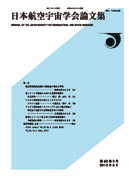All issues

Volume 28, Issue 316
Displaying 1-5 of 5 articles from this issue
- |<
- <
- 1
- >
- >|
-
Akira KUBOZONO1980Volume 28Issue 316 Pages 217-225
Published: May 05, 1980
Released on J-STAGE: May 25, 2009
JOURNAL FREE ACCESSDownload PDF (528K) -
Hideya TAIRA, Hiroshi YAGI1980Volume 28Issue 316 Pages 225-231
Published: May 05, 1980
Released on J-STAGE: May 25, 2009
JOURNAL FREE ACCESSDownload PDF (1182K) -
1980Volume 28Issue 316 Pages 232-238
Published: May 05, 1980
Released on J-STAGE: May 25, 2009
JOURNAL FREE ACCESSDownload PDF (2046K) -
The Structure of the Outer Intermittent Region in Adverse Pressure Gradient Turbulent Boundary LayerShoji SAKURAI, Yasujiro KOBASHI1980Volume 28Issue 316 Pages 239-248
Published: May 05, 1980
Released on J-STAGE: May 25, 2009
JOURNAL FREE ACCESSThe outer intermittent region of turbulent boundary layer in adverse pressure gradient with U1∝(x-x0)-0.20 has been extensively investigated to study a large scale structure.
By using the conditional sampling and spacetime correlation techniques, the measurements led to an average picture of the velocities in the turbulent bulge.
The results show that there exists a mean circulatory flow inside the interface, and are not inconsistent with previous measurements investigated in the boundary layers without pressure gradient.View full abstractDownload PDF (575K) -
Kazuo NAKAGAWA1980Volume 28Issue 316 Pages 248-256
Published: May 05, 1980
Released on J-STAGE: May 25, 2009
JOURNAL FREE ACCESSTemperature distributions of a communication satellite antenna composed of a horn and a reflector were studied. Antenna temperature is primarily determined by the solar heating, which varies in accordance with the solar incidence angle and its intensity. Monte Carlo method was introduced to calculate the solar heating in order to deal with the self-shading of the antenna and with the mixed specular-diffuse reflection. The spectrum of the reflected light differs from that of the irradiated if the reflectance of the material has spectrum dependence, which mostly holds true in real cases. And since the absorptance is a function of the spectrum of the incident light, this spectrum change after reflection causes a change of the absorptance. In the present ray tracing process of the Monte Carlo method, the spectrum of the light and the absorptance for it are reevaluated at each reflection.
In order to show the effectiveness of this method, temperature distributions were calculated using nodal analysis, and the results were compared with thermal vacuum test data. The solar simulator used is a divergent type powered by Xenon lamps, its characteristics had to be taken into consideration adding to the above-mentioned correction. The calculated results showed good agreement with the measured test data, and also the influence of the diverging light was made clear comparing with the results assuming a parallel solar beam.View full abstractDownload PDF (525K)
- |<
- <
- 1
- >
- >|